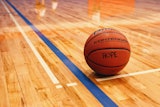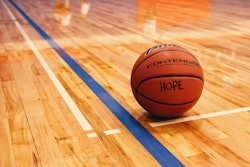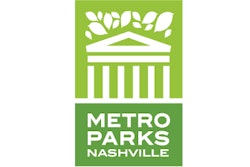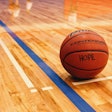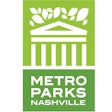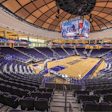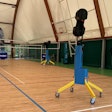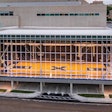New environmental regulations and more sophisticated polymer formulations have combined to change the gym floor coating game.
 Photo of New Orleans Arena, home of the New Orleans Hornets professional basketball team
Photo of New Orleans Arena, home of the New Orleans Hornets professional basketball team
The people that comprise Indiana's renowned basketball history are legends: Larry Bird, John Wooden, Oscar Robertson, George McGinnis, Steve Alford, Isiah Thomas. Also legendary are the state's gyms and field houses, veritable museums of hoops history: IU's Assembly Hall, Butler's Hinkle Fieldhouse, and nine of the 10 largest high school gyms in the United States.
It follows that the people responsible for the maintenance of these hallowed facilities take a long-established tack, right down to the maple floors. "We're pretty traditional in Indiana with our gyms," says Byron Haflich, president of A&H Athletic Floor Services Inc., based in Noblesville. "I personally like the look of a floor that has a slightly golden hue. You'll find very few gym floors in Indiana that are done to look stark white."
To achieve that traditional aesthetic, Haflich - like other contractors throughout the state, depending on the specifications of a given client - still takes the time-honored approach of treating bare sanded wood with oil-based sealer (often in two coats), followed by game lines and other court paint, and finally two coats of oil-modified polyurethane finish.
"That's the classic, old-school, solvent-based coating," says Howard Brickman, who founded Brickman Consulting 25 years ago and has diagnosed wood floor problems for clients throughout the country. "That's been the common method for the past 25 to 30 years."
But that model - or at least the coatings it involves - has slowly been changing, as 18 states and counting have placed more stringent limitations on the levels of volatile organic compounds allowed in wood floor sealers, stains and finishes. "All those do-it-yourselfers, the people who use their own maintenance staff to recoat their floors, they've traditionally made up a very strong solvent-based market, until these changes to the VOC regulations," says Brickman.
Manufacturers, too, have been refining their formulations to offer more environmentally friendly and aesthetically dynamic solvent- and water-based coatings, giving buyers of gym floor coatings more options than ever.
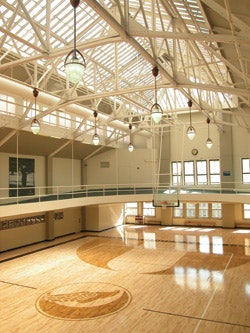 Photo of basketball court flooring
Photo of basketball court flooringVOCs combine with nitrogen oxide and ultraviolet light to produce ground-level ozone, which diminishes indoor air quality and potentially causes pulmonary problems in people exposed to it. The federal regulation for the vast majority of gym floor finishes (oil-modified polyurethane and water-based) is 450 grams of VOCs per liter. There are some proprietary coatings that are solvent-based but not oil-modified, but as Brickman explains, "the wild card for all solvent-based coatings are the regulations of the amounts of allowable VOCs."
California was the first state to further restrict VOC levels, reducing the grams-per-liter allowance for finishes to 350 (statewide, that may be down to 275 by next year). Member states of the Ozone Transport Commission - an organization created under the Clean Air Act that is made up of states from the Northeast and Midwest - have since followed suit. (Indiana, coincidentally, is the latest, and new VOC limitations are expected to take effect there in January.)
For manufacturers of traditional oil-modified polyurethane - which is commonly referred to as OMU, poly or, more generically, oil-based - the stricter regulations have required increased research and development. "When we started regulating these coatings 20 years ago, the first thing manufacturers did was just reduce the amounts of solvents, often to disastrous effect" related to ease of application and drying, says Brickman. "The allowance has progressively gotten smaller over the years, and each reduction in VOCs essentially requires a reformulation."
The restrictions also have created new openings in the marketplace for more environmentally friendly water-based finishes. On the whole, water-based finishes cure faster than oil-based and are equally if not more durable. The kicker: They are more expensive.
"Your labor hours are pretty much the same whether you go with solvent-based or water-based," says Haflich. "We like to use a high-quality water-based product, and we're paying about $60 per gallon, covering about 700 to 750 square feet. There are water-based out there for half as much, but I like to use what I think is best. Depending on whose you buy, the average price for a good, Maple Flooring Manufacturers Association-approved, 45-percent-solids, solvent-based finish is about $20 to $25 per gallon."
Cost, however, may not be a clear indicator of the quality of a finish. Contractors and facility operators alike have their own opinions about what finishes apply and perform best. "We've tried and tested a lot of products since 1975 and we've pretty much weeded out those products that we think fail for whatever reason," says Tricia Thompson, co-owner of Mesa, Ariz.-based Enmar Hardwood Flooring.
 Photo of basketball court flooring
Photo of basketball court flooringBrickman says gym floor contractors have two primary concerns related to finishing products - staying within budget and consistency/ease of application. Still important but of secondary concern in their minds are the facility operator/owner's primary concerns - aesthetics and durability. "Price is basically what's kept oil-modified poly in the market," Brickman says. "All things being equal, except for maybe a slight difference in durability, the contractors are going to go with the product with the lower cost and the easier application."
As for aesthetics, oil-based and water-based each have their advantages, with oil-based tending to yellow with time to create the "golden hue" favored in the Hoosier State, and water-based essentially going on clear. But as Thompson points out, more aesthetically diverse options for water-based products have emerged. "Now you can get water-based finishes that are in a semi-gloss or even gloss sheen levels," she says. Haflich notes that at least one manufacturer markets a water-based sealer designed to produce a light amber hue.
Beyond regulatory obligations, facility operators may specify which coatings are to be used, based on their own environmental concerns. Low-VOC coatings can be used to achieve points in the U.S. Green Building Council's LEED accreditation process. Coating providers, meanwhile, have recognized the importance of offering environmentally responsible products and have begun to market certain product lines as "green." One major manufacturer has gone so far as to get numerous coating products certified to the most stringent level set by the industry-independent, nonprofit GREENGUARD Environmental Institute, which develops ANSI standards for low-emitting products.
Unfortunately, as Thompson notes, preference in gym floor finishes most often comes back to cost. "I think people want to be environmentally sensitive but, this year especially, cost is the top priority."
Most wood flooring experts recommend refinishing gym floors at least once a year, depending on the amount and types of usage. While the process works just as well for water-based refinishes, oil-based finishes demand the traditional screen-and-recoat method. The floor is thoroughly cleaned, and discs made of fiberglass screens are affixed to the bottom of an automatic floor polisher or buffer used to abrade the surface, preparing it for the adhesion of a new coat.
"It's certainly a viable technique; millions and millions of wood floors have been refinished by screening and recoating," says Brickman, adding that the most common error maintenance personnel will commit in the process is not regularly replacing the screens. "They do get duller and duller, and at a certain point you'll find that the screen is no longer doing enough to prepare the surface for adhesion."
 Photo of the basketball court floor at North Central
Photo of the basketball court floor at North CentralAlso keep in mind with screening and coating that trapped grit can produce visible circular scratches in the abraded surface, and lots of surprisingly far-flung dust is generated.
At least two coating manufacturers offer chemical-adhesion systems, which work only with water-based finishes. The floor is thoroughly cleaned or buffed, depending on the system, and then treated with a bonding seal coat. That adhesive coat goes down thin (approximately 3,500 square feet can be covered by a single gallon, Haflich says of the system he regularly uses) and a water-based finish then goes on top of it. From an application perspective, says Haflich, "The cleanup is great; there's no dust at all."
Though gym floor maintenance programs will vary, experts agree that maintaining strict usage policies and a cleaning regimen are essential in maximizing the life of any floor's finish. Enmar offers the following general maintenance guidelines (available in more detail at https://www.enmarflooring.com/gym-floor-maintenance-program.php):
- Always prohibit the use of street shoes on the floor and place mats that catch each foot twice at gym entrances.
- Using a clean mop dedicated only to the gym floor, dust-mop as often as every two hours.
- Using a damp mop or automatic scrubber in conjunction with a cleaning solution, thoroughly clean the floor at least once per week.
Haflich offers yet another maintenance tip, his favorite: "If you've got a new floor, do exactly what your flooring contractor tells you to do," he says. "If there's a problem - and wood floors will have problems - the first question they'll ask is, 'How have you been maintaining the floor?' If your answer is different than what they told you to do, you could void your warranty. If your contractor tells you to spit on your floor, then spit on it."













